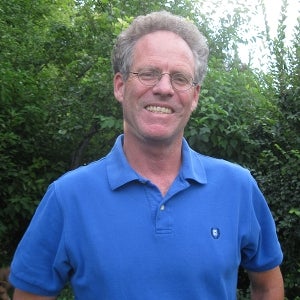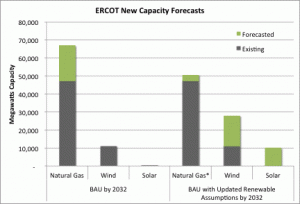
Wyoming Outdoor Council’s lead attorney on air quality
EDF and Wyoming Outdoor Council are teaming up to protect air and water quality from oil and gas development in the Cowboy State. One of the first efforts in this partnership surrounds strengthening air quality regulation for the oil and gas industry in Pinedale, WY where persistent ozone pollution threatens the health of local residents. EDF’s Natural Gas Media Director, Lauren Whittenberg, recently sat down with Bruce Pendery, Wyoming Outdoor Council’s lead attorney on air quality issues, and Jon Goldstein, EDF’s Senior Energy Policy Manager, to learn more about this partnership.
Lauren Whittenberg: Can you tell me about the pollution problems in Pinedale?
Bruce Pendery: Well, first and foremost, this pollution is a public health issue. Monitoring of air quality in the Upper Green River Basin in western Wyoming near Pinedale started to show dangerous levels of ground level ozone pollution in 2006. Ground level ozone (also known as smog) is created by a complicated interaction between two different forms of air pollution, oxides of nitrogen and volatile organic compounds. Oil and gas development in the Pinedale area is the main source of both. Since the problem was identified, the Wyoming Outdoor Council has been heavily engaged with regulators, local citizens and industry to seek a way to reduce this harmful pollution to protect the local citizens and gas field workers.
LW: What problems does ozone pollution cause?
Jon Goldstein: Ozone is a toxic air pollutant widely known to cause a host of respiratory problems. Exposure to ozone pollution, even in low concentrations, can cause serious health problems, including permanent damage to the lungs. To address some of these concerns, EPA introduced rules – for the first time – that established federal emission standards for natural gas well sites, as well as tightened existing standards for other aspects of gas processing and distribution. EPA’s clean air measures are important to reduce air pollution from the oil and gas sector. It’s also interesting to note that EPA – in part – based these federal standards on state level rules that have been in place in Wyoming for several years. However, a big opportunity exists to further strengthen federal and state regulations and reduce air pollution for communities dealing with poor air quality.
LW: What is the plan to address this harmful pollution?
BP: On January 10, the Wyoming Department of Environmental Quality (DEQ) announced its plan to address air pollution issues in the Pinedale area’s Upper Green River Basin. This plan is based on recommendations the department received from the Upper Green River Basin Air Quality Citizens Advisory Task Force, a broad group of local citizens, elected officials, oil and gas industry and environmental representatives brought together by the department. I served on this task force and helped formulate the ten consensus recommendations we provided to the DEQ.
LW: What were the recommendations?
BP: These are very practical, common sense efforts to reduce emissions from oil and gas operations. Things like monitoring, investigating and plugging leaks from faulty oil and gas production equipment, reducing emissions from produced water tanks and ponds, and developing legal efforts to better regulate existing sources of pollution.
LW: You mentioned that these recommendations were “consensus.” What does that mean?
JG: That is what is so encouraging about this effort. Each of the ten recommendations has the buy in of every member of the task force – a very broad group of local citizens and elected officials as well as industry and environmental groups like Wyoming Outdoor Council. These practical recommendations followed nine months of deliberations by the task force and six lengthy meetings.
That such a broad group could reach consensus on ten methods to improve local air pollution is a testament to their dedication. This hard work will be well worth it when these ideas are made a regulatory reality, and air quality issues in the region begin to improve.
LW: What’s next?
JG: This action plan is a key first step; the DEQ has offered an outline that, if implemented quickly and completely, will help put us on the path toward cleaner, healthier air. But now is a crucial time in this process. It is now up to the DEQ to make these ideas a reality and implement them through regulatory processes as quickly as possible.
And we aren’t stopping with these ten items. We have advocated for additional efforts to improve air quality, including better measures to monitor maintenance activities such as liquids unloading, extending the state’s strong Presumptive Best Available Control Technology (P-BACT) requirements throughout the ozone nonattainment area, and ensuring that existing and grandfathered emissions sources are controlled.
A lot is at stake. Inaction or inadequate action will not improve air quality or protect the health of local residents.
LW: How will Wyoming Outdoor Council and EDF keep this momentum going?
BP: We will remain involved in this process to ensure that the DEQ follows through as quickly as possible. We plan to be very active in the formal regulatory development and adoption processes that will kick off in the coming months. And we hope that all Wyoming citizens will stay involved in this effort. Wyoming has a strong history of leadership in regulating air emissions from the oil and gas sector. Our plan is to defend this hard-earned reputation and protect people and our air quality in the process.
LW: What other efforts are on tap in Wyoming?
JG: Because of both the strong regulatory tradition that Bruce mentioned, and Wyoming’s status as one of the largest sources of domestic oil and gas resources, Wyoming is one of our target states for EDF’s natural gas work. We are working on a number of opportunities to raise the bar on air and water quality regulations and also improve drilling protections on federal lands. This includes adoption of strong new federal rules around the venting and flaring of natural gas. You will hear more about these efforts in coming months, but we are very happy to have a partner as well respected and experienced as Wyoming Outdoor Council to help us make them a reality.
LW: Thank you both.
 Did you know that 40% of the electricity used to power home electronics is consumed while they are turned off? And did you know the electricity it takes to power a single 100-watt light bulb for one year is generated by 713 pounds of coal?
Did you know that 40% of the electricity used to power home electronics is consumed while they are turned off? And did you know the electricity it takes to power a single 100-watt light bulb for one year is generated by 713 pounds of coal?














